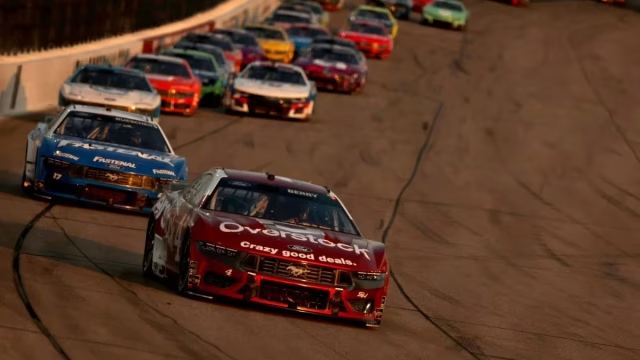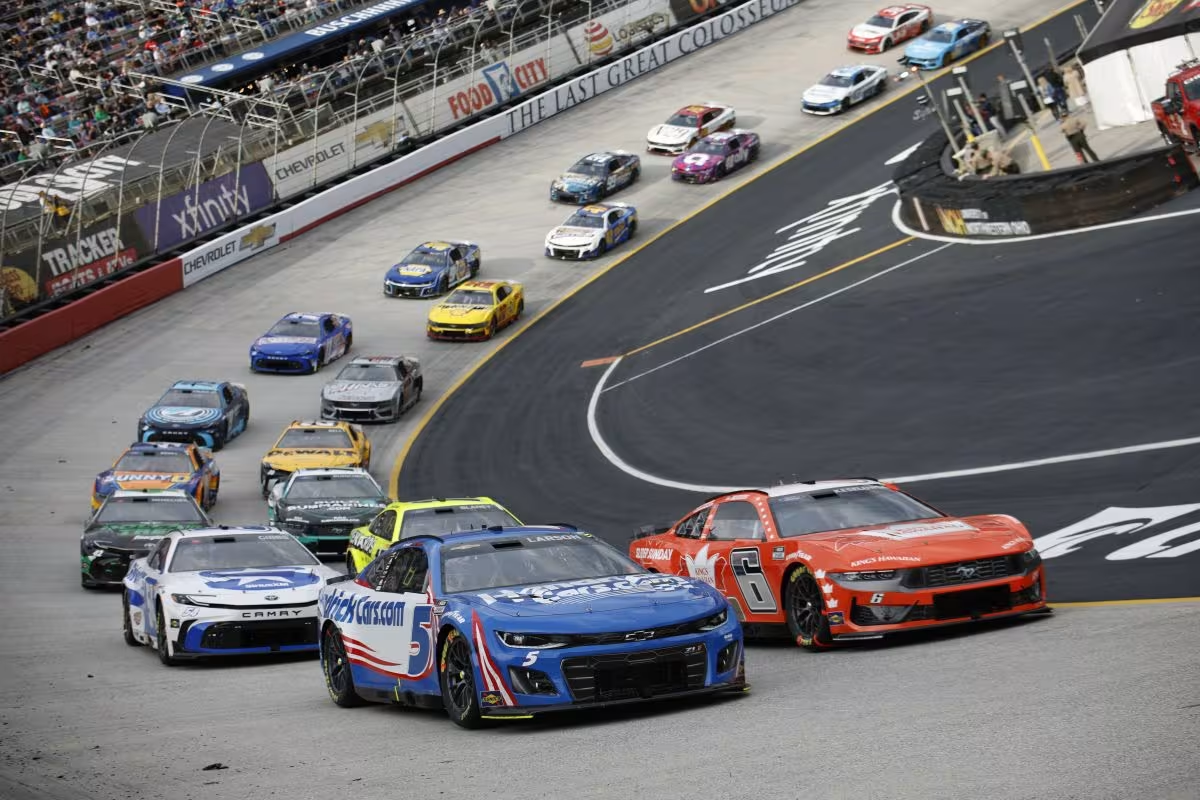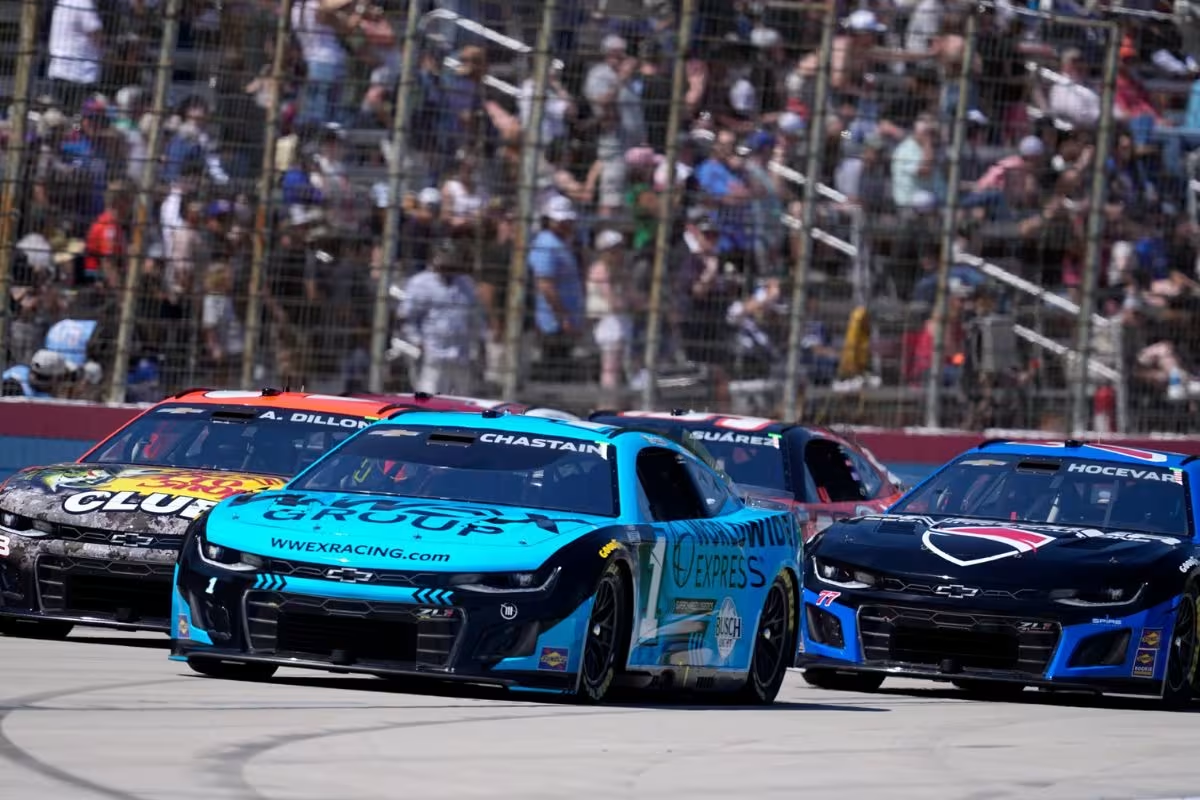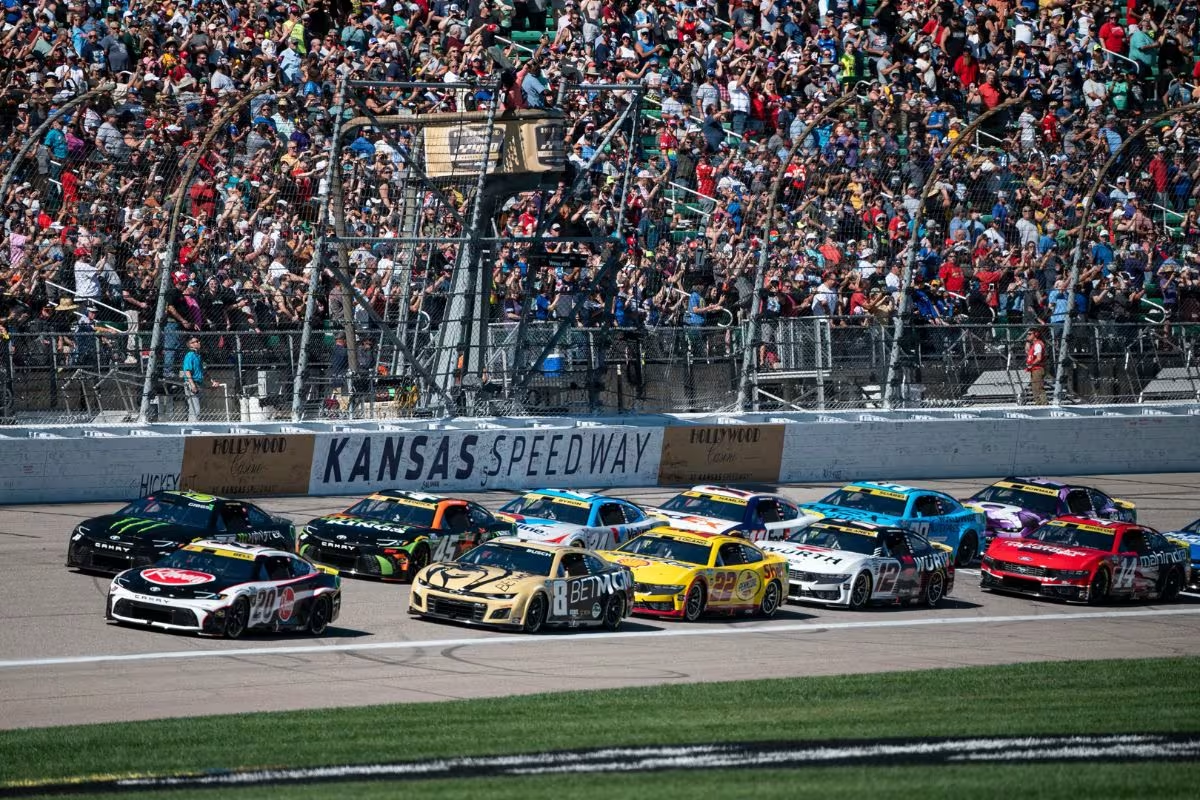The recent YellaWood 500 at Talladega has sparked concerns about NASCAR manipulating the Damaged Vehicle Policy (DVP) for playoff drivers. With a massive crash involving 28 cars, questions about fairness and favoritism began swirling. Why were some damaged cars allowed to race on while others were sent back? As drivers like Josh Berry voice their frustrations, the integrity of NASCAR’s rules is under scrutiny.
Key Highlights
- Fans perceive manipulation of the DVP rules, suggesting favoritism towards playoff drivers, especially after recent controversial incidents at Talladega.
- Only select drivers, like Chase Elliott and Chase Briscoe, received towing assistance during the crash, raising questions about criteria application.
- Competitors like Josh Berry highlight disparities in DVP enforcement, calling for a transparent and consistent approach to rule application.
- NASCAR’s communication lapses during incidents have fueled frustration and speculation about potential bias in officiating practices.
- Ongoing discussions about the DVP rule emphasize the need for equitable protocols to restore trust and credibility in NASCAR’s governance.
The Controversial Use of DVP at Talladega
After the YellaWood 500 at Talladega, a lot of questions arose about how NASCAR’s Damaged Vehicle Policy (DVP) was applied. The race featured a massive crash involving 28 cars, creating chaos and confusion for the officials trying to enforce the DVP.
While only Chase Elliott and Chase Briscoe were towed back to their pits, many other damaged cars stayed on the track. This raised concerns about how officials decide which drivers get help under the DVP.
Typically, the policy says that cars that can not move because of damage should be out of the race. However, this rule seemed to be applied differently during the Talladega race.
The situation was made worse by comparing it to Ryan Blaney’s experience at Watkins Glen, where he was taken out of the race for a similar problem. This inconsistency made some fans wonder if certain drivers, especially popular ones or those in the playoffs, are getting special treatment.
This raises serious questions about the fairness of the DVP and NASCAR’s officiating. If fans feel that the rules aren’t applied equally, it could hurt the sport’s reputation. NASCAR needs to take a close look at how the DVP is enforced to ensure fairness for everyone.
Elton Sawyer’s Explanation of the DVP Tweaks
Amid growing concerns about favoritism in the enforcement of the Damaged Vehicle Policy (DVP), NASCAR’s senior vice president, Elton Sawyer, offered insights aimed at clarifying recent adjustments. He emphasized that the primary objective of the DVP has been to prevent competitive teams from being unfairly eliminated due to damage. “Our goal from day one when this policy came into place was not to put good cars or good trucks out of the race,” Sawyer stated, defending the rationale behind the policy’s implementation.
“Our goal from day one when this policy came into place was not to put good cars or good trucks out of the race. So the way we executed that over the last three years, the policy hasn’t changed. The cars that we did tow back this past weekend were able to get back on the racetrack and meet minimum speeds.” – Sawyer
Sawyer noted that while the DVP hasn’t fundamentally changed over the past three years, adjustments have been made to accommodate unique race situations, particularly during critical playoff moments.
He acknowledged the need for ongoing evaluation of the policy’s effectiveness, stating, “We have set programs and set policy… to make certain that it’s still providing the efficiencies.” This proactive approach indicates NASCAR’s commitment to refining its regulations, albeit amid examination regarding perceived favoritism toward playoff drivers.
“We have set programs and set policy. We’d said we’re gonna take a deeper dive into it in the off-season just to make sure that it’s still providing the efficiencies, providing the benefits that we want from that, but also be able to correct some of the things that obviously haven’t worked well with that policies.” – Sawyer
🗣️ "The policy hasn't changed." #NASCAR's Elton Sawyer addresses the damaged vehicle policy after Sunday's chaotic wreck in @TALLADEGA and last weekend's incident at @kansasspeedway.
More → https://t.co/MKhd9eLXG8 pic.twitter.com/pS93SBqKXq
— SiriusXM NASCAR Radio (Ch. 90) (@SiriusXMNASCAR) October 8, 2024
Fans’ Frustration with NASCAR’s DVP Decisions
Frustration erupted among NASCAR fans following recent decisions regarding the Damaged Vehicle Policy (DVP), as many questioned the consistency and transparency of the enforcement during critical races. The stakes involved, particularly with playoff drivers, intensified examination of the officiating crew’s judgment.
Fans noted a disconcerting lack of clarity surrounding the DVP, particularly during chaotic incidents like the notable crash at Talladega, where 28 cars were impacted.
- Inconsistent Application: Critics argued that the DVP seemed to be applied unevenly, particularly favoring certain drivers, which undermined the integrity of the competition.
- Communication Breakdown: The confusion surrounding the hybrid yellow/red flag indicated a lapse in communication from NASCAR officials, leaving fans and teams bewildered about the race’s status and rules.
- Perception of Favoritism: The notion that playoff drivers received preferential treatment in DVP rulings has led to speculation about NASCAR’s motivations, casting shadows over the sport’s credibility.
“I did not know what in the hell was going on at Talladega. None of it made any sort of sense. Especially with that odd hybrid yellow/red flag they had going on.”- fans’ reaction
In view of these issues, fans are left grappling with the implications of NASCAR’s DVP decisions. The combination of high-profile crashes and perceived inconsistencies has fueled a narrative of favoritism and conspiracy, raising alarms about the future direction of the sport.
Josh Berry’s Frustration Over DVP Rule Application
Recent controversies surrounding NASCAR’s Damaged Vehicle Policy (DVP) have sparked intense reactions from multiple drivers, with Josh Berry emerging as a vocal critic. Berry’s frustration primarily stems from perceived inconsistencies in the application of the DVP, especially during the Kansas race where he suffered flat tires. He expressed his ire about the apparent double standards, questioning how other drivers, such as John Hunter Nemechek, were able to continue despite severe damage, while he was sidelined.
“The 42 car (John Hunter Nemechek) was over there doing burnouts, slinging rubber all over the safety workers, trying to get going. If you have four flat tires and you got to get towed to pit road, you’re done, right?” – Berry
This inconsistency raises critical questions about the fairness of the DVP application. Berry’s remarks underscore a growing sentiment among fans and participants that the rules may be selectively enforced, particularly favoring playoff contenders. His call for transparency reflects a broader demand for accountability within NASCAR’s regulatory framework.
Berry’s frustrations are emblematic of a larger narrative in NASCAR, where the integrity of race regulations is scrutinized. As the sport continues to evolve, the necessity for a consistent and fair application of rules like the DVP remains paramount to maintaining trust among drivers and fans alike.
“Tell that to the 4 team!!!” – fans’ reaction
Speculation Over Favoritism Toward Playoff Drivers
The perception of favoritism towards playoff drivers has ignited a heated debate within the NASCAR community, particularly following incidents during key races. Fans are increasingly questioning the integrity of race protocols, especially regarding the Damage Vehicle Policy (DVP) and its application to drivers like Chase Elliott, who was involved in a crash yet seemingly received preferential treatment to salvage his race day.
“So like every other rule it’s Nascar gets to decide in the moment with clear bias and incompetency and no one gets to complain or else.”
“So then it really was just playoff driver favoritism. What a surprise the two cars that got a tow were playoff guys and one was Chase Elliott.”
“The problem is NASCAR is the one deciding whether or not a car is still able to race. Let the team and the DVP clock make that call. If a team wants to be towed to the pit, tow to the pit, drop it, and start the DVP clock.” – fans reaction
Critics have pointed out several factors fueling this speculation:
- Selective Enforcement: The DVP rule’s application appears inconsistent, especially when playoff drivers are involved, raising concerns about fairness and transparency.
- Towing Decisions: The choice to tow certain cars, particularly those of playoff contenders, has led to accusations that NASCAR is manipulating outcomes to favor specific drivers.
- Protocol Clarity: A lack of clarity in the enforcement of the DVP has resulted in confusion and frustration among teams and fans alike, undermining trust in the governing body.
As discussions around potential tweaks to the DVP rule gain momentum, it will be critical for NASCAR to establish protocols that are perceived as equitable.
Transparency in decision-making processes and consistency in the application of racing rules are vital for restoring faith among fans and competitors alike, as the integrity of the sport hangs in the balance.
News in Brief: NASCAR Manipulating DVP For Playoff Drivers
The debate over how NASCAR’s Damaged Vehicle Policy (DVP) was handled highlights the ongoing struggle between fairness and competition. Changes made during the Talladega race, along with explanations from officials and reactions from drivers, have led many fans to believe that playoff drivers might be getting special treatment.
These feelings can shake fans’ trust in the sport’s integrity. To keep credibility and ensure that all drivers have a fair chance, NASCAR needs to openly address these concerns. It’s essential to maintain a level playing field for everyone involved in the sport.
ALSO READ: NASCAR Unfair to Smaller Teams? Small Team Owner Shares NASCAR Realities



